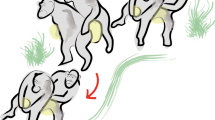Abstract
Human dance may have originated from selection to display quality in courtship. This proposal is based on comparative investigation of variation in motor skills in relation to mate preference and selection. However, scholars have also proposed that dance has evolved as a by-product of imitative proficiency. In this view, imitative proficiency plays a central role in dance learning and performance and facilitates movement synchronization among dancers and thus social bonding. Here we comment on a recent paper (Laland et al. in Current Biology, 26, R5–R9, 2016), which favors the latter perspective. We suggest that social bonding through dance has evolved in consequence of the adaptive problem of assessing mate qualities and other social information from body movement. This information may then have been used in strengthening social cohesion.
Similar content being viewed by others
References
Buss, D. M., & Schmitt, D. P. (1993). Sexual Strategies Theory: An evolutionary perspective on human mating. Psychological Review, 100, 204–232.
Byers, J. A., Hebets, E., & Podos, J. (2010). Female mate choice based upon male motor performance. Animal Behavior, 79, 771–778.
Fink, B., Weege, B., Neave, N., Ried, B., & do Lago, O. C. (2014). Female perception of male body movement. In V. A. Weekes-Shackelford & T. K. Shackelford (Eds.), Evolutionary perspectives on human sexuality and behavior (pp. 299–324). New York: Springer Business-Media.
Fink, B., Weege, B., Neave, N., Pham, M. N., & Shackelford, T. K. (2015). Integrating body movement into attractiveness research. Frontiers in Psychology, 6, 220.
Fink, B., André, S., Mines, J.S., Weege, B., Shackelford, T.K., & Butovskaya, M. (in press). Sex difference in attractiveness perceptions of strong and weak male walkers. American Journal of Human Biology.
Hanna, J. L. (2010). Dance and sexuality: many moves. Journal of Sex Research, 47, 212–241.
Laland, K., Wilkins, C., & Clayton, N. (2016). The evolution of dance. Current Biology, 26, R5–R9.
Neave, N., McCarty, K., Freynik, J., Caplan, N., Hönekopp, J., & Fink, B. (2011). Male dance moves that catch a woman’s eye. Biology Letters, 7, 221–224.
Sell, A., Hone, L. S., & Pound, N. (2012). The importance of physical strength to human males. Human Nature, 23, 30–44.
Weege, B., Pham, M. N., Shackelford, T. K., & Fink, B. (2015). Physical strength and dance attractiveness: further evidence for an association in men, but not in women. American Journal of Human Biology, 27, 728–730.
Author information
Authors and Affiliations
Corresponding author
Rights and permissions
About this article
Cite this article
Fink, B., Shackelford, T.K. Why Did Dance Evolve? A Comment on Laland, Wilkins, and Clayton (2016). Evolutionary Psychological Science 3, 147–148 (2017). https://doi.org/10.1007/s40806-016-0075-3
Published:
Issue Date:
DOI: https://doi.org/10.1007/s40806-016-0075-3




